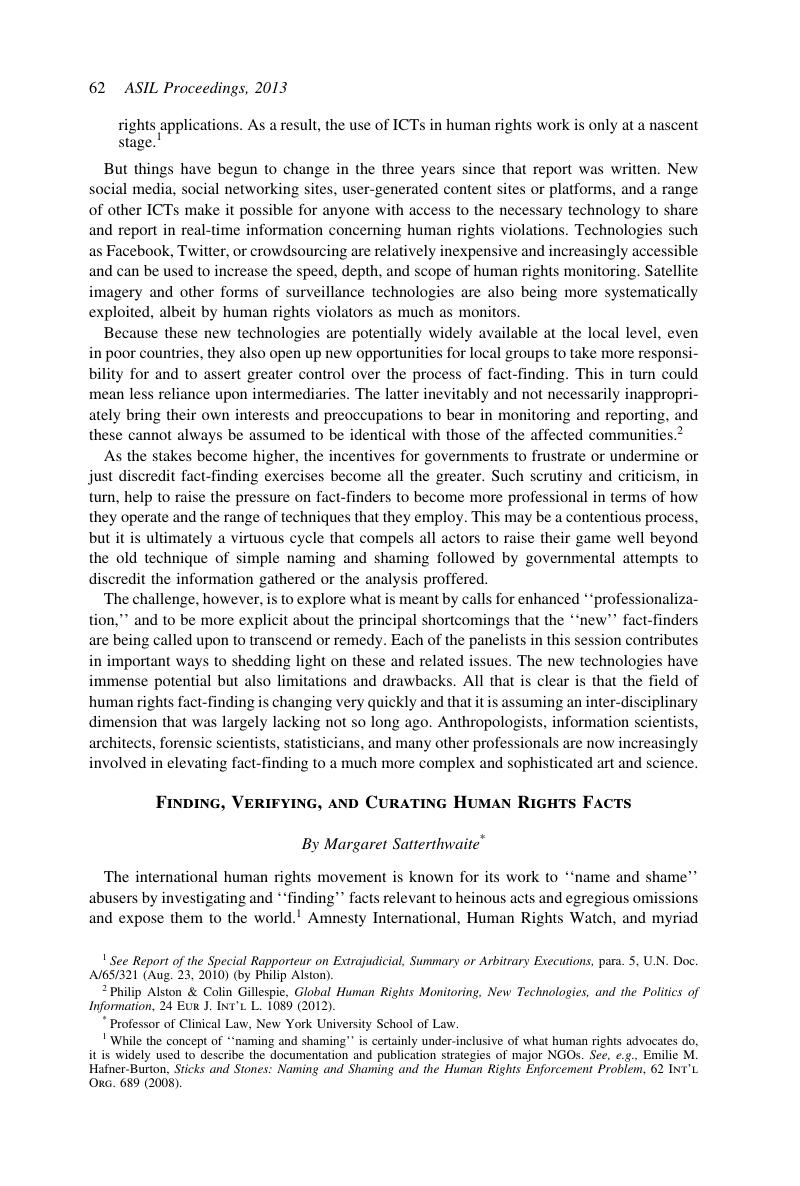Article contents
Finding, Verifying, and Curating Human Rights Facts
Published online by Cambridge University Press: 20 January 2017
Abstract

- Type
- The Future of Human Rights Fact-Finding
- Information
- Copyright
- Copyright © American Society of International Law 2014
References
1 While the concept of “naming and shaming” is certainly under-inclusive of what human rights advocates do, it is widely used to describe the documentation and publication strategies of major NGOs. See, e.g., Hafner-Burton, Emilie M., Sticks and Stones: Naming and Shaming and the Human Rights Enforcement Problem, 62 Int’l Org. 689 (2008)CrossRefGoogle Scholar.
2 Gready, Paul, Telling Truth? The Methodological Challenges of Truth Commissions, in Methods of Human Rights Research 159–85, 160 (Coomans, Fons, Granfeld, Fred & Kamminga, Menno T. eds., 2009)Google Scholar.
3 Wilson, Richard, Representing Human Rights Violations: Social Contexts and Subjectivities, in Human Rights, Culture & Context: Anthropological Perspectives 134–60 (1997)Google Scholar.
4 See Gready, Paul, Introduction: “Responsibility to the Story,” 2 J. Hum. Rts. Prac. 177 (2010)CrossRefGoogle Scholar.
5 Navanethem Pillay, United Nations High Commissioner for Human Rights, Human Rights Investigations and Their Methodology (Feb. 24, 2010), at http://unispal.un.Org/UNISPAL.NSF/0/C9222F058467E6F6852576D500574710.
6 For a discussion of the dangers of professionalization for the human rights field, see Kennedy, David, The International Human Rights Regime: Still Part of the Problem?, in Examining Critical Perspectives on Human Rights 19–34 (Dickinson, Rob, Katselli, Elena, Murray, Colin & Pedersen, Ole W. eds., 2012)Google Scholar.
7 For example, see Steinberg, Gerald M., Herzberg, Anne & Berman, Jordan, The Need for Standardized Fact-Finding Methodology, in Steinberg, Gerald M., Herzberg, Anne & Berman, Jordan, Best Practices for Human Rights and Humanitarian NGO Fact-Finding 3–19 (2012)CrossRefGoogle Scholar.
8 For example, see Guidelines on International Human Rights Fact-Finding Visits and Reports: The Lund-London Guidelines (June 1, 2009), http://www.factfindingguidelines.org/.
9 Langford, Malcolm & Fukuda-Parr, Sakiko, The Turn to Metrics, 30 Nordic J. Hum. Rts. 222, 223 (2012)Google Scholar.
10 See United Nations, Manual on the Effective Prevention and Investigation of Extra-Legal, Arbitrary and Summary Executions, U.N. DOC. E/ST/CSDHA/.12 (1991).
11 Id.
12 Nancy Combs, Fact-Finding Without Facts: The Uncertain Evidentiary Foundations of International Criminal Convictions 7 (2010).
13 Id. at 12.
14 Id. at 13–14.
- 1
- Cited by




